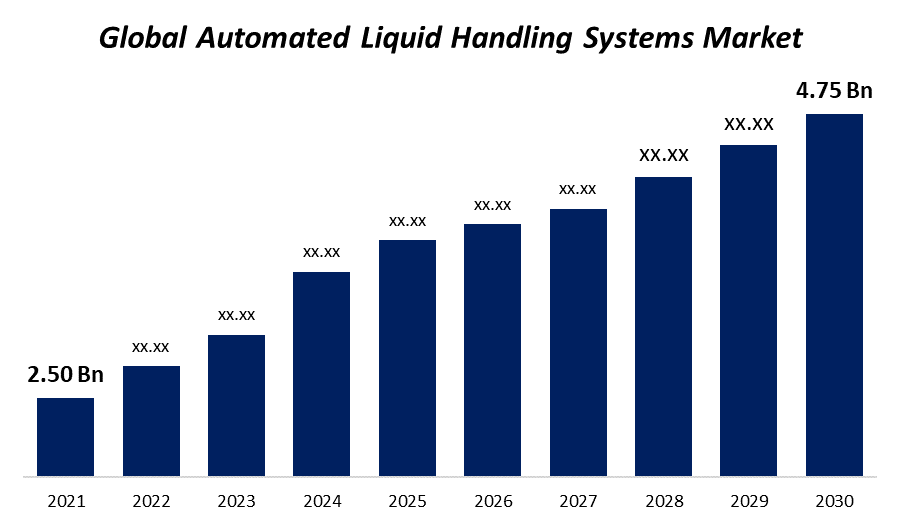Global Automated Liquid Handling Systems Market Size, Share, and COVID-19 Impact Analysis, By Product (Automated Liquid Handling Workstations, Reagents & Consumables), By Application (Drug Discovery & ADME-Tox Research, Cancer & Genomic Research, Bioprocessing/Biotechnology, Others), By End-user (Academic & Research Institutes, Pharmaceutical & Biotechnology Companies, Contract Research Organizations), By Region (North America, Europe, Asia-Pacific, Latin America, Middle East, and Africa), Analysis and Forecast 2021 - 2030
Industry: HealthcareGlobal Automated Liquid Handling Systems Market Size Insights Forecasts to 2030
- The Global Automated Liquid Handling Systems Market SIze was valued at USD 2.50 billion in 2021.
- The Worldwide Market Share is growing at a CAGR of 12.08% from 2022 to 2030
- The Global Automated Liquid Handling Systems Market Size is expected to reach USD 4.75 billion by 2030
- Asia Pacific is expected to grow the fastest during the forecast period

Get more details on this report -
The Global Automated Liquid Handling Systems Market Size is expected to reach USD 4.75 billion by 2030, at a CAGR of 12.08% during the forecast period 2022 to 2030.
Market Overview
Automated liquid handling (ALH) systems are devices that are carefully configured to manage liquids and provide exact, repeatable outcomes in clinical and research settings without any complication. In clinical and research labs, effective and precise liquid handling techniques are crucial. For usage in methods like ELISA, time-resolved fluorescence, nucleic acid preparation, PCR setup, next-generation sequencing for genomic research, TLC spotting, SPE, and liquid-liquid extraction, automated liquid handling systems can be made more effective. Automatic liquid handling equipment has a number of benefits, including the ability to simplify sample preparation while keeping high precision, allowing labs to run more samples while maintaining repeatability, and reducing the need for manual labour. By shortening setup times and protocol creation, it aids in sample preparation requirements for proteins, metabolites, as well as genomics and NGS applications.
Report Coverage
This research report categorizes the market for Automated Liquid Handling Systems market based on various segments and regions and forecasts revenue growth and analyzes trends in each submarket. The report analyses the key growth drivers, opportunities, and challenges influencing the Automated Liquid Handling Systems market. Recent market developments and competitive strategies such as expansion, product launch and development, partnership, merger, and acquisition have been included to draw the competitive landscape in the market. The report strategically identifies and profiles the key market players and analyses their core competencies in each sub-segments of the Automated Liquid Handling Systems market.
Driving Factors
The market is expected to be driven by the introduction of new automated liquid handling workstations for non-contact dispensing. Contact dispensing has become widely accepted throughout time thanks to its dependability, simplicity, and affordability. The main reasons propelling the growth of the liquid handling system market are the increase in investments in drug discovery, the increase in R&D spending, the rise in need for high output screening, and the rise in use of automation in clinical settings. Rising R&D initiatives for novel drug development and biotechnology research are also fueling the market's expansion. The development of vaccines and increasing investment by new drug companies are boosting the market for liquid handling systems. Manufacturers are releasing new drugs onto the market to fight disease incidence and spur market expansion. The introduction of automated liquid handling systems that can handle huge numbers of PCR tests with reliable clinical results is causing R&D and testing volume to be accelerated, which is driving the market's expansion.
Global Automated Liquid Handling Systems Market Report Coverage
| Report Coverage | Details |
|---|---|
| Base Year: | 2021 |
| Market Size in 2021: | USD 2.50 Billion |
| Forecast Period: | 2021-2030 |
| Forecast Period CAGR 2021-2030 : | 12.08% |
| 2030 Value Projection: | USD 4.75 Billion |
| Historical Data for: | 2017-2020 |
| No. of Pages: | 199 |
| Tables, Charts & Figures: | 119 |
| Segments covered: | By Product, By Application, By End-user, By Region, COVID-19 Impact Analysis |
| Companies covered:: | AGILENT TECHNOLOGIES, INC. (BIOTEK INSTRUMENTS, INC.), AURORA BIOMED INC, CORNING INCORPORATED, DANAHER CORPORATION (BECKMAN COULTER INC.), EPPENDORF AG, GILSON, INC., HAMILTON COMPANY, METTLER-TOLEDO INTERNATIONAL INC., PERKINELMER, INC., TECAN GROUP LTD |
| Growth Drivers: | The market is expected to be driven by the introduction of new automated liquid handling workstations for non-contact dispensing. |
| Pitfalls & Challenges: | COVID-19 Empact, Challenge, Future, Growth, & Analysis |
Get more details on this report -
Restraining Factors
The running expenses and complexity of the liquid handling system are considerable, which is limiting the market's expansion.
Market Segmentation
- In 2021, the Automated Liquid Handling Workstations accounted the largest market share over the forecast period
On the basis of product, the automated liquid handling systems market is segmented into Automated Liquid Handling Workstations, Reagents & Consumables. Among these, the automated liquid handling workstations accounted the largest market share over the forecast period. Based on their assembly and kind, automated liquid handling workstations can be further divided. These devices are divided into standalone and integrated workstations depending on their assembly, and multipurpose workstations, pipetting workstations, specialist liquid handlers, and workstation modules based on their kind. The deployment of automated workstations is driven by the escalating competition between pharmaceutical companies and their pursuit of new medications to treat ailments. Higher market penetration of standalone pipettors is attributed to their tiny footprint and ability to integrate with other devices with nanoliter capabilities.
- In 2021, the drug discovery and ADME-Tox research is dominating the market over the forecast period.
Based on application, the automated liquid handling system is segmented into Drug Discovery & ADME-Tox Research, Cancer & Genomic Research, Bioprocessing/Biotechnology, Others. Among these, the drug discover and ADME-Tox research is dominating the market over the forecast period. In a single drug discovery experiment, nearly a million molecules are screened to find a new therapeutic candidate. Microarray technology demonstrates the typical criteria of liquid handling, such as high throughput, low volume, and great accuracy and precision. Stepwise serial dilution over a large concentration range, compound selection and transfer for retest, confirmatory and further analysis are only a few of the many applications in drug discovery and ADME-Tox. Automated liquid handling workstations are primarily utilised in drug discovery and ADME-Tox research for plate-to-plate dilutions, plate replications, and plate reformatting. One key benefit of adopting automated liquid handling systems in drug development is the possibility to integrate several types of liquid handlers, stackers, or incubators to increase throughput.
- In 2021, the pharmaceutical and biotechnology segment is dominating market over the forecast period.
On the basis of end user, the automated liquid handling system is segmented into Academic & Research Institutes, Pharmaceutical & Biotechnology Companies, Contract Research Organizations. Among these, the pharmaceutical and biotechnology segment is dominating market over the forecast period. For drug discovery facilities, automated liquid handlers were developed. Its rapid expansion in drug discovery and manufacture is being facilitated by the regular requirement to distribute liquid samples on different substrates and transfer them to containers of varied sizes. Pharma and biotech firms are anticipated to continue to dominate the market in the years to come as a result of this rise in the usage of automation for drug screening and drug development.
Regional Segment Analysis of the Automated Liquid Handling Systems Market

Get more details on this report -
- North America (U.S., Canada, Mexico)
- Europe (Germany, France, U.K., Italy, Spain, Rest of Europe)
- Asia-Pacific (China, Japan, India, Rest of APAC)
- South America (Brazil and the Rest of South America)
- The Middle East and Africa (UAE, South Africa, Rest of MEA)
North America is dominating the market over the forecast period.
Due to the well-established distribution networks of the key market participants and the quick uptake of advanced automation solutions, North America dominated the market in 2022 with the biggest revenue share. Growth in this area is further fueled by the demand for small volume genomic and proteomic analyses for life science research. To boost their revenue, rivals in this region have partnered with prestigious academic institutions and research institutions in Europe.
Recent Developments
- In October 2020, For analysing the cannabis and hemp flower sample, one of the major players, PerkinElmer, unveiled the first Completely Automated Process for Cannabis & Hemp Pesticide Residue.
- In January 2021, Apricot Designs was acquired by SPT Labtech. As part of its portfolio of automation solutions for structural biology, drug discovery, sample management, genomics, biobanking, and cryo-electron microscopy, SPT will increase the variety of liquid handling technologies it offers through this acquisition.
Competitive Analysis:
The report offers the appropriate analysis of the key organizations/companies involved within the global Automated Liquid Handling Systems market along with a comparative evaluation primarily based on their product offering, business overviews, geographic presence, enterprise strategies, segment market share, and SWOT analysis. The report also provides an elaborative analysis focusing on the current news and developments of the companies, which includes product development, innovations, joint ventures, partnerships, mergers & acquisitions, strategic alliances, and others. This allows for the evaluation of the overall competition within the market.
List of Key Companies
- AGILENT TECHNOLOGIES, INC. (BIOTEK INSTRUMENTS, INC.)
- AURORA BIOMED INC
- CORNING INCORPORATED
- DANAHER CORPORATION (BECKMAN COULTER INC.)
- EPPENDORF AG
- GILSON, INC.
- HAMILTON COMPANY
- METTLER-TOLEDO INTERNATIONAL INC.
- PERKINELMER, INC.
- TECAN GROUP LTD
Key Target Audience
- Market Players
- Investors
- End-users
- Government Authorities
- Consulting And Research Firm
- Venture capitalists
- Value-Added Resellers (VARs)
Market Segment
This study forecasts revenue at global, regional, and country levels from 2019 to 2030. Spherical Insights has segmented the global Automated Liquid Handling Systems market based on the below-mentioned segments:
Automated Liquid Handling Systems Market, By Product
- Automated Liquid Handling Workstations
- Reagents & Consumables
Automated Liquid Handling Systems Market, By Application
- Drug Discovery & ADME-Tox Research
- Cancer & Genomic Research
- Bioprocessing/Biotechnology
- Others
Automated Liquid Handling Systems Market, By End User
- Academic & Research Institutes
- Pharmaceutical & Biotechnology Companies
- Contract Research Organizations
Automated Liquid Handling Systems Market, Regional Analysis
- North America
- US
- Canada
- Mexico
- Europe
- Germany
- Uk
- France
- Italy
- Spain
- Russia
- Rest of Europe
- Asia Pacific
- China
- Japan
- India
- South Korea
- Australia
- Rest of Asia Pacific
- South America
- Brazil
- Argentina
- Rest of South America
- Middle East & Africa
- UAE
- Saudi Arabia
- Qatar
- South Africa
- Rest of Middle East & Africa
Need help to buy this report?